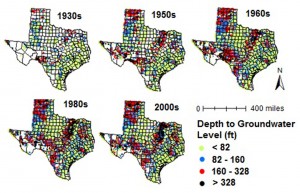New Study Shows Rate of Groundwater Decline Slowing in Texas
Scientists at Texas A&M AgriLife Research have published the first long-term statewide survey of Texas groundwater.
According to the study, statewide median groundwater levels fell by about 70 feet, or 22 meters, between 1930 and 2000, although the changes vary greatly between areas of the state. The rate of decline in groundwater levels has slowed in recent years, attributed to new policy and technology in water conservation.
“Our intention is just to give an overview of what’s happening in terms of these long-term groundwater levels. It varies across the state. There are some areas where the water level declines are much deeper and in some areas there has not been a huge difference,” says Srinivasulu Ale, an author of the study and assistant professor at Texas A&M AgriLife Research.
Declining groundwater levels are influenced by several factors identified in the study. Most notably, the growing population, expected to double in Texas by 2060, has intensified demands on groundwater. In the U.S., daily groundwater use more than doubled between 1950 and 2005, according to the study.
The growth of cities and neighborhoods has also prevented groundwater from being replenished in many cases.
“With urbanization comes all these parking lots and built-up areas which were otherwise soil. With all these impervious surfaces the rainwater makes its way to the streams,” says Ale. “If these impervious layers were not there, a portion of the water would have recharged the groundwater.”
Soil type and geology also determine how well groundwater can be replenished. Clay soils or dense shale can prevent water from seeping into the Earth where as sandy soils allow it to quickly sink into deep reservoirs. However, sandy soils have also allowed for groundwater contamination with nitrate and fluoride, chemical byproducts of fertilizers.
In 2008, groundwater provided 60 percent of water used in Texas, according to the Texas Water Development Board (TWDB), and irrigation and agriculture accounted for 80 percent of the state’s yearly water use.
Previous surveys of groundwater were aquifer-specific or short term, says Ale, but this study used TWDB data dating back to 1896 and surveyed all of Texas, even areas outside the state’s nine major and 21 minor aquifers.


